The First and Second world wars caused a rise in patriotism as citizens across the country sought to contribute to the war effort. Away from the trenches and on the home front, in true Hoosier fashion Indiana University faculty, students and the Bloomington community rose admirably to the challenge to meet the very pressing issue of wartime food consumption.
Part 1: The Great War

With the entrance of the United States into the war in April 1917, the importance of agricultural aid and the nation’s food security increased exponentially. In August 1917, the Food and Fuel Control Act passed Congress and President Wilson created the Food Administration with Herbert Hoover named as head of the division. “Food Will Win the War” quickly became the slogan aimed at the American public to produce more and consume less in the name of victory by rethinking old patterns of consumption, a tactic that was so successful that it was used again during WWII. IU President William Lowe Bryan urged everyone to do their part:
Your first thought everyday should be in what most effectively serve your country in the greatest crisis in its history. If we are worthy to enjoy the liberty won for us by Washington and Lincoln, we must now fight for it anew.
While young and able American men fought on the battlefields, women, children, the elderly and those left behind fought to ensure the security of the nation’s food supply and that of the allies.
The University Farm and the Corn Crib


Following a call from Indiana Governor James P. Goodrich to increase food production, the city of Bloomington formed the Vacant Lot Garden Committee and the University allocated nearly 55 acres both to the north and in the heart of campus for tilling. In April 1917, the Indiana Daily Student reported that “almost every foot of available ground will be planted…The demand for teams to plow up vacant lots has set the price of this item soaring.”
Roughly northeast of the recently completed Men’s Gymnasium (the present day School of Public Health building), the University approved the removal of several trees and a plot of about seven acres was plowed and made available for garden plots. Similarly, according to several accounts, a corn crib was erected to store the produce on the hill directly north of the old Assembly Hall (razed in 1938).
Student and Faculty Involvement
In addition to their coursework, student groups across campus such as the Women’s Athletic Association stepped up to plant gardens. In 1917, a special course on agriculture was taught by Frederick John Breeze, a Fellow in the Department of Geology.
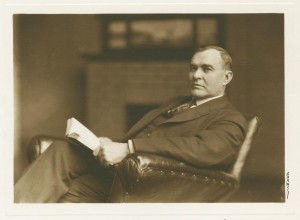
Outside of the classroom, faculty members such as William Frederick Book (Educational Psychology) and David Andrew Rothrock (Mathematics) used their personal property for the cause. Book planted potatoes in his “newly plowed bluegrass lawn” and Rothrock “raised a ton of honey” in his backyard. Even Theodore Louden, proprietor of the Alpha Hall dormitory, put out a garden, likely for the student cafeteria.
The “Back to the Farm” Movement
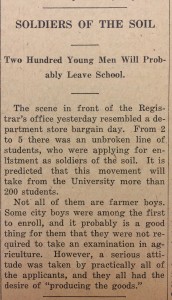
With every farmer being asked to plant and produce more than ever, school authorities across the country took steps to aid in the planting of the spring crop. President Bryan implored the student body to the cause stating that:
The food campaign is just now the most essential part of our great war. We wish, therefore, to provide for the enlistment for the food campaign in a manner as nearly as possible like that required of those who enlist in the army.

Similar to the guidelines for cases of military enlistment, the Indiana Daily Student outlined the program stating that those:
who enlist in this work will receive entire credit for every hour they are carrying. For example, if a student is carrying fifteen hours of work, he will receive twelve hours of credit for his regular subjects, and the remaining three in general University credit or elective work.
According to the May 29, 1917 Indiana Daily Student a total of 217 students withdrew to become “soldiers of the soil.”
Lorena and Dorritt Degner

While the farm movement campaign primarily targeted male students, sisters Lorena and Dorritt Degner (a senior and junior respectively) eventually gained permission to withdraw from classes and return to their family farm near Winamac, Indiana.
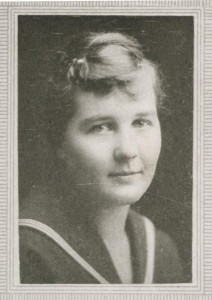
In June, Lorena reported their activities to President Bryan in a letter:
Enlistment has ended, but work of course, is still going on, with corn-cultivating, laying and harvesting yet to be done. My brother and I have 40 acres of corn to cultivate, which will keep us busy until harvesting.
My average day of work was about 9 ½ hours and would have been a little more if rain had not stopped work two or three times. I did a little plowing, but almost all of my farm work has been farrowing and cultivating. My shortest day, except when it rained, was 8 hours, my longest 12.
After June 4, two hours each morning were spent in herding cows to pasture….
I am afraid this is becoming tedious. I question whether I have really done much for my country; I do think I have done more than by staying at I.U. and I am certainly glad you gave me an opportunity.
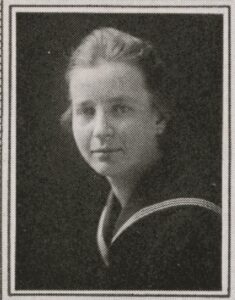
Tragically, Lorena I. Degner was killed in 1923 while on leave from her position as a nurse in the U.S Veterans’ Hospital No. 85 at Walla Walla, Washington. A train struck the bus in which she was traveling. President William Lowe Bryan, upon hearing of her death, paid her the following tribute in the October Alumni Quarterly:
I have been deeply shocked by the news of the death of Miss Lorena Degner. I remember her as one of our best students. She graduated from the University in 1918 with high distinction.
I remember especially one incident. In 1917 the University permitted boys to go home in order to work on the farms in the interest of a large food supply in support of our army. One day Miss Lorena Degner and her sister, Miss Dorrit Degner (now Mrs. S.C. Sledge), came into my office and asked to be released for work at home. I said that the release was given only for those who were going to work in the fields. They said that they were going home for that purpose. Those two girls were accordingly released along with hundreds of boys for this splendid was service. They deserve to be recognized along with the soldiers who went to the front.
Food and the War Courses
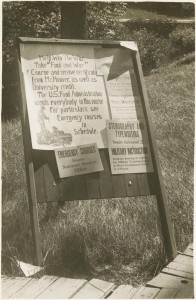
The United States Food Administration turned to the country’s centers of education such as IU to “secure that degree of assistance in handling our food problems that cannot be obtained elsewhere.” The Federal Food Administrator for Indiana implored President William Lowe Bryan:
The food situation is such that only the closely-knit co-operation of all our best citizens can suffice to avert conditions that a year ago would have seemed unbelievable. WILL YOU HELP?”
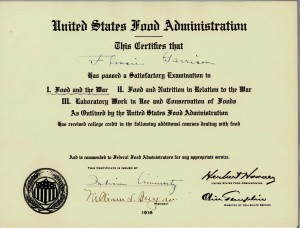
In response, during the spring 1918 semester the University offered several courses directly tied to the war effort such as Food and the War, Foundations of Food and Nutrition and Conservation of Foods. Students such as Flosie Garrison (A.B. in English) and Alda Woodward (A.B. in Latin) received certificates of completion from the US Food Administration following a course taught by Home Economics Professor Edith Williams. They went on to become teachers after the war.
Wheatless, Meatless and Sugarless
As the war progressed, wheatless, meatless, and sugarless days were adopted at dinner tables across the nation, the local homes, boarding and Greek houses and the University Cafeteria. Faculty members such as Mabel Wellman of the Home Economics department offered lectures to the student body and the community on food conservation methods such as canning and drying and gave recommendations for suitable substitutes for wheat such as barley, buckwheat, corn, oatmeal, rice and potato flours.
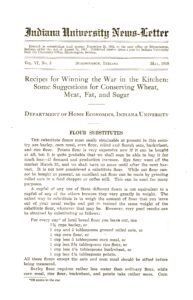
Sample menus and recipes were printed in the local papers and the Extension Division distributed the newsletter “Recipes for Winning the War in the Kitchen.” Additionally, in cooperation with the Extension Divisions of Iowa and Wisconsin they produced three films on gardening, canning and drying which were immediately put into circulation in July 1917 in four states. While the films no longer exist, at the time Walton S. Bittner of the Extension Division reported that:
Calls for the films have been coming in rapidly….The Films are good. They accomplish their main purpose of helping to keep the idea of conservation before the public. They also give definite instruction in methods.
The Hennel-Hendricks Family
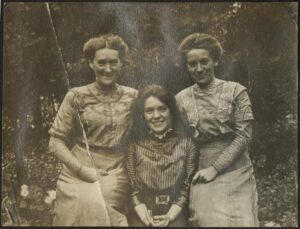
Former IU faculty member Cecilia Hennel Hendricks regularly wrote her sisters Cora (an IU Professor of Mathematics) and Edith back in Bloomington from her bee farm in Powell, Wyoming. During the war years she recounted substituting wheat flour in recipes such as potato crackers and making apple-sauce barley cake from a recipe that the family sent her from the Indiana Daily Student. Cecilia also shared stories about honey from their farm being used by the Allies, local canning and drying demonstrations, and the specifics of canning vegetables, fruit, rice and meats such as chicken and even jack rabbit. In a letter dated October 12, 1917, she tells them:
To be sure there are some canned meats that are better than jack rabbit, but in this day and age – and especially region – jack rabbit is preferable to some things at three and four times the price. If you are interested get the government bulletin on canning meat, and be prepared. The government recommends killing off the cockerels and old hens in the fall, and canning them, so as to save feeding them over winter. You could do the rabbits same as chickens. Jack rabbit meat makes lovely meat loaf and brown stews and macaroni mixtures and mince meat, not to mention hassen pfeffer.
~~~~~~~~~~~~~~~~~~~~~~~~~~~~~~~~~~~~~~~~~~~~~~~~~~~~~~~~~
Coming next week – Part 2: World War II
Leave a Reply